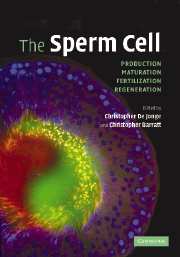Book contents
- Frontmatter
- Contents
- Preface
- List of contributors
- 1 Mammalian spermatogenesis and sperm structure: anatomical and compartmental analysis
- 2 Sperm chromatin stability and susceptibility to damage in relation to its structure
- 3 Genomic and proteomic approaches to defining sperm production and function
- 4 Sperm maturation in the human epididymis
- 5 Controls of sperm motility
- 6 Regulation of capacitation
- 7 Reactive oxygen species: friend or foe
- 8 Testing sperm manufacturing quality: the sperm–zona binding assay
- 9 Genetics: a basic science perspective
- 10 Sex chromosome abnormalities and male infertility: a clinical perspective
- 11 Epigenetic patterning in male germ cells: importance of DNA methylation to progeny outcome
- 12 The DAZ gene family and human germ cell development from embryonic stem cells
- Index
Preface
Published online by Cambridge University Press: 14 August 2009
- Frontmatter
- Contents
- Preface
- List of contributors
- 1 Mammalian spermatogenesis and sperm structure: anatomical and compartmental analysis
- 2 Sperm chromatin stability and susceptibility to damage in relation to its structure
- 3 Genomic and proteomic approaches to defining sperm production and function
- 4 Sperm maturation in the human epididymis
- 5 Controls of sperm motility
- 6 Regulation of capacitation
- 7 Reactive oxygen species: friend or foe
- 8 Testing sperm manufacturing quality: the sperm–zona binding assay
- 9 Genetics: a basic science perspective
- 10 Sex chromosome abnormalities and male infertility: a clinical perspective
- 11 Epigenetic patterning in male germ cells: importance of DNA methylation to progeny outcome
- 12 The DAZ gene family and human germ cell development from embryonic stem cells
- Index
Summary
In the past decade greater emphasis has been placed on investigation of the human male gamete. As a consequence many unique and revealing characteristics have been identified; providing greater insight and understanding regarding human sperm production, maturation, and function. However, there has not been a comprehensive book on these topics published for more than 8 years. The focus of this book will be on the human and where data is lacking non-human animal species will be substituted to serve as representative example.
The composition of the spermatozoon, always regarded as critical for successful fertilization, has gained even greater significance in the events post-fertilization. The fidelity of the genome in its composition and construction are known to significantly influence fertilization, embryogenesis and live birth. Several contributions to this book elegantly detail the overt and more subtle characteristics of both the competent and dysfunctional sperm genome complex.
Historically, the spermatozoon has somewhat been viewed as a typical single cell; meaning that its membranes, organelles and metabolic activities are all connected. Emerging data clearly demonstrates the uniqueness of the spermatozoon in that discrete compartments can be identified whose physiology and biochemistry are separable. Several of the chapters herein offer intriguing revelations in this regard.
The yin and yang image that forms the central core of the micrograph on the front of this book serves as a symbolic reflection of the book's subtitle: production, maturation, fertilization, regeneration.
- Type
- Chapter
- Information
- The Sperm CellProduction, Maturation, Fertilization, Regeneration, pp. vii - viiiPublisher: Cambridge University PressPrint publication year: 2006



